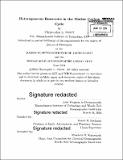| dc.contributor.advisor | Daniel H. Rothman. | en_US |
| dc.contributor.author | Follett, Christopher L | en_US |
| dc.contributor.other | Woods Hole Oceanographic Institution. | en_US |
| dc.date.accessioned | 2014-10-08T15:21:27Z | |
| dc.date.available | 2014-10-08T15:21:27Z | |
| dc.date.copyright | 2014 | en_US |
| dc.date.issued | 2014 | en_US |
| dc.identifier.uri | http://hdl.handle.net/1721.1/90666 | |
| dc.description | Thesis: Ph. D., Joint Program in Oceanography (Massachusetts Institute of Technology, Department of Earth, Atmospheric, and Planetary Sciences; and the Woods Hole Oceanographic Institution), 2014. | en_US |
| dc.description | 122 | en_US |
| dc.description | Cataloged from PDF version of thesis. | en_US |
| dc.description | Includes bibliographical references (pages 149-158). | en_US |
| dc.description.abstract | Understanding the fate of primary production in the ocean is a challenging task because once produced, organic material is oxidized over timescales which range from minutes, to millions of years. This timescale diversity is matched by an equal heterogeneity in both the local physical and chemical environment. In this thesis we explore the relationship between the distinct reservoirs of organic carbon in the ocean and their underlying complexity. First, we show how the heterogeneity of portions of the carbon cycle can be packaged in terms of age structured models and their accompanying age and rate distributions. We further relate the moments of the rate distributions to bulk reservoir properties like average age and flux. Explicit relationships are then derived for the specific case of a single turnover time and a lognormal distribution. We apply these ideas to the problem of dissolved organic carbon (DOC) cycling in the ocean. Current models of bulk concentration and isotope data suggest a microbially sourced DOC reservoir consisting of two components. A nearly homogeneous background component with a long turnover time (> 6000 years) is joined by a component of fast turnover time (~ 1 year) and equal concentration in the surface ocean. We confirm the presence of isotopically enriched, modern DOC co-cycling with an isotopically depleted older fraction in the upper ocean. However, our results show that up to 30% of the deep DOC reservoir is modern and supported by a 1 Pg per year carbon flux, ten times higher than inferred from bulk isotope measurements. Isotopically depleted material turns over at an apparent time scale of 30, 000 years, far slower than indicated by bulk isotope measurements. These results are consistent with global DOC measurements and explain both the fluctuations in deep DOC concentration and the anomalous radiocarbon values of DOC in the Southern Ocean. Finally, the thesis explores methods for determining the validity of diffusion limitation as the mechanism behind the power-law slowdown in organic remineralization in sediment. We find that diffusion limitation connects the decay behavior of organic material to the correlations found between mineral surface area and organic matter content in sediments. | en_US |
| dc.description.statementofresponsibility | by Christopher L. Follett. | en_US |
| dc.format.extent | 158 pages | en_US |
| dc.language.iso | eng | en_US |
| dc.publisher | Massachusetts Institute of Technology | en_US |
| dc.rights | M.I.T. theses are protected by copyright. They may be viewed from this source for any purpose, but reproduction or distribution in any format is prohibited without written permission. See provided URL for inquiries about permission. | en_US |
| dc.rights.uri | http://dspace.mit.edu/handle/1721.1/7582 | en_US |
| dc.subject | Joint Program in Oceanography. | en_US |
| dc.subject | Earth, Atmospheric, and Planetary Sciences. | en_US |
| dc.subject | Woods Hole Oceanographic Institution. | en_US |
| dc.subject.lcsh | Seawater Carbon dioxide content | en_US |
| dc.subject.lcsh | Organic compounds | en_US |
| dc.title | Heterogeneous reservoirs in the marine carbon cycle | en_US |
| dc.type | Thesis | en_US |
| dc.description.degree | Ph. D. | en_US |
| dc.contributor.department | Joint Program in Oceanography | en_US |
| dc.contributor.department | Woods Hole Oceanographic Institution | en_US |
| dc.contributor.department | Massachusetts Institute of Technology. Department of Earth, Atmospheric, and Planetary Sciences | |
| dc.identifier.oclc | 890406983 | en_US |

